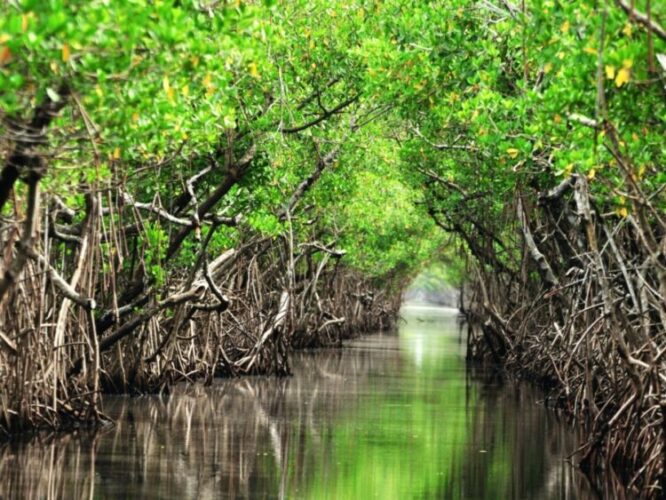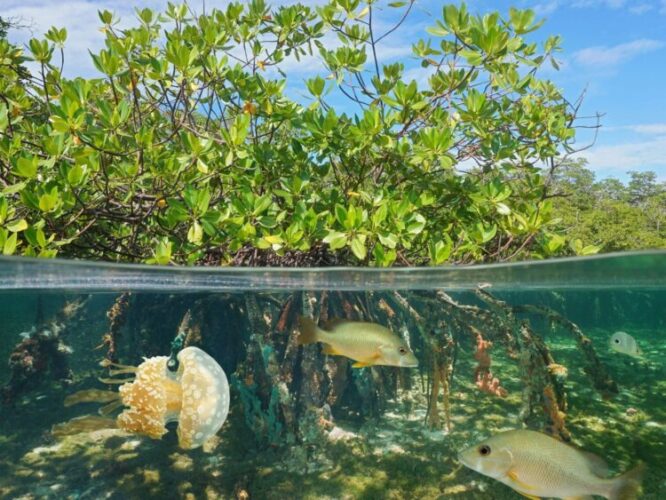When one-fifth of the mangroves on our planet have already disappeared, three-quarters of those that still exist are threatened, according to specialized UN agencies.
Mangroves are viewed by some as “dirty spots” or “dead zones,” vacant lands that could be cleared for sandy beaches and other development projects. However, these coastal forests are home to the only trees that thrive in salt water, improve water quality by filtering out nutrients and sediment, are the source of life for many plant and animal species, and provide many other benefits, including for human populations.

But despite their usefulness, these ecosystems are disappearing, and the main reason is the so-called coastal urban development, which consists of cutting down mangroves to build buildings, fish farms, and facilities aimed at reproducing highly valuable and marketable marine species. .
Experts estimate that mangrove forests are disappearing three to five times faster than the total loss of forests in the world. Globally, one-fifth of mangroves have disappeared, and it is estimated that more than three-quarters of existing species are threatened, and with them all aquatic and terrestrial organisms that depend on them.
Let us appreciate the importance of mangrove ecosystems and mention here some of the benefits they provide, which are relevant.
They have the power to combat climate change.
To curb climate change, the world urgently needs to reduce polluting emissions and remove carbon from the atmosphere; In this latter task, mangroves are key, because these coastal ecosystems extract up to five times more carbon than terrestrial forests.
Mangroves incorporate carbon into their leaves, branches, roots and the sediment beneath, which raises the land surface and slows sea level rise. Under the right environmental conditions, these ecosystems can store the carbon they have taken from the atmosphere for decades, centuries, or even thousands of years.
– Protection from severe weather and natural disasters.
Mangroves not only help prevent the worsening of climate change, but also play an important role in reducing its impact, as extreme weather events such as storms and floods are becoming more frequent as global temperatures rise.
Faced with such hazards, mangrove trunks absorb the shock of the waves, making them excellent defenses against such hazards. Mangroves have also been shown to be an effective defense against tsunamis, reducing wave heights by between 5% and 35%. Therefore, restoring and protecting mangroves is a critical way to increase the resilience of coastal communities and national economies.
They are the natural habitat for endangered species
Of the more than 1,500 species that depend on mangroves to survive, 15% are at risk of extinction. This number is increasing if we look at mammals, as nearly half of those that live or feed in the mangroves could become extinct in the coming years; And the trends are getting worse for most of them. Therefore, protecting and restoring mangroves means restoring critical habitats for endangered animal species.
– Increase the food security of the population
As refuges for biodiversity, mangrove forests foster the reproduction and maintenance of a wide range of plants and animals, many of which are important for food production, such as fish.
For 1.5 billion people, fish is the most important source of protein, and in low-income countries with food shortages, nearly 20% of the average animal protein intake comes from fish. The disappearance of mangroves would have enormous implications for fisheries in developing countries, while their restoration would mean a significant contribution of young, edible fish and invertebrates of great commercial value to coastal waters.
Mangroves can recover naturally
Bringing life back to lost ecosystems is a daunting task; But it is possible to do so. One of the most effective ways to protect and restore degraded mangrove forests is to improve recognition of the collective rights and actions of indigenous peoples across the spectrum of environmental governance and environmental rule of law, as envisaged in the Kunming-Montreal Global Framework on Biodiversity. .

This is a particularly important aspect given that, according to the specialists, “on a global scale, indigenous peoples are the guardians of 80% of the planet’s biodiversity, with 5,000 unique traditional cultures and ancestral lands covering 32% of all continental land and waters of 90 countries.
Positive experiences in mangrove restoration have been developed in different parts of the world, adapting them to local conditions. Understanding and addressing the causes of mangrove loss is the first step towards restoring this important ecosystem on Earth, an action that should be a global priority for the benefit of all humanity.
(Sources: UNEP news websites, UNESCO and the United Nations).

“Award-winning alcohol trailblazer. Hipster-friendly internetaholic. Twitter ninja. Infuriatingly humble beer lover. Pop culture nerd.”
